Samsung: Galaxy Fold Is Tested to Fold/Unfold 200,000 Times
by Anton Shilov on March 28, 2019 4:10 PM EST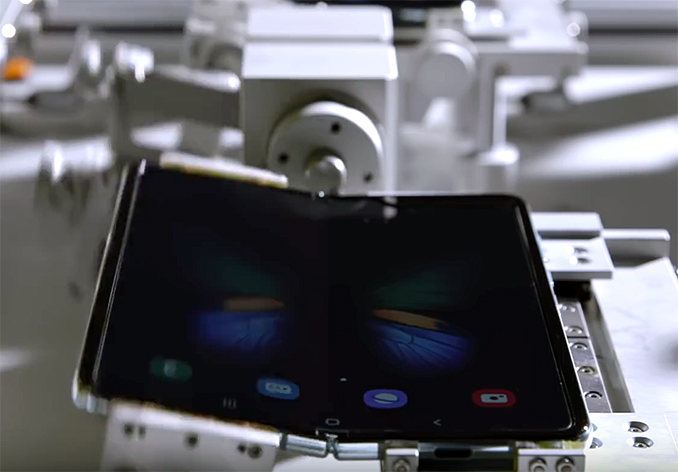
Foldable smartphones are still to prove their value proposition in the market, and we will see if they become popular among end users. It goes without saying that foldable handsets represent a technological challenge in the unique way smartphones are used. Samsung, through a released video, has stated that its Galaxy Fold device is not only impressive in terms of technology, but is also reliable enough to be folded and unfolded for over 100 times a day for five years. The company even published a video showing how it tests the handset for reliability.
Galaxy Fold, Unfold, Fold, Unfold, Fold, Unfold, Fold, Unfold, Fold
There are several challenges that companies like Samsung face when developing foldable smartphones. Firstly, they required a 0 – 180º fully inward (or outward) foldable AMOLED display. Secondly, they needed to develop a lightweight and durable hinge. Thirdly, they had to build internal electronics/cabling in such a way that they would survive thousands of fold/unfold cycles. Fourthly, they needed to design software/firmware to enable owners to use foldable handsets efficiently (e.g., switch from cover displays to main ones, tailor Android apps for larger screens, etc.).
When it comes to foldable hardware, reliability is a must. Samsung states that smartphones are used for ~100 times a day on average, so the AMOLED displays (as well as hinges) have to survive years of active usage without harming color reproduction or rigidity. If one folds and unfolds their phone for ~100 times a day, then the number of fold/unfold cycles the handset will have to survive will total 182,500 in five years (100*365*5). Since people may use it slightly differently, Samsung tests its Galaxy Fold smartphones for 200,000 folds and unfolds, just to make sure, the company said. In fact, the manufacturer has even built a robot that can perform such tests and demonstrated its work on a new video.
One thing to note about the number of fold/unfold cycles that smartphones have to survive is the actual use case - depending on how often users will actually open up the device. With a screen on the outside, one might argue that Samsung devices will not be unfolded as often as say, the Huawei version. But the new form factor may indicate new use cases that current smartphoens are not being used for. Therefore, a $1980/€2000£1799 question is whether foldable smartphones will survive a new use model.
Ian: It's worth pointing out that it should be obvious the reasons why and how Samsung (and Huawei, and others) test the folding repetative act on their devices. All smartphone manufacturers do physical testing of their devices the same way, and at scale - if there's a button, it gets pushed 100k-500k times. If there's a headphone jack, one gets put in 100k-500k times. If there's a fingerprint sensor, it gets tested 100k-500k times. If it has a drop rating, it gets tested for being dropped. Pretty much everyone does the testing how you would expect - I've seen several testing labs as a reviewer and they really all look pretty much the same. Most companies will test a certain number of devices every batch to ensure compliance with their own internal testing; what will differ between the companies is what they define as 'acceptable use', and how that ties in to the warranty. The key thing here is that not every device is tested up to the 200k - just a select from from each batch. It is likely that those coming off the line might be tested a few times (100-500) just to remove any potential 'early failures' that can occur, so devices are not dead on arrival.
Related Reading:
- Samsung Galaxy Fold Set to Be Available in UK on April 26: £1799
- Samsung Announces The Galaxy Fold: The First Folding Display Smartphone
- Samsung Galaxy S10 5G: Launch Date & Approximate Price Revealed
Source: Samsung


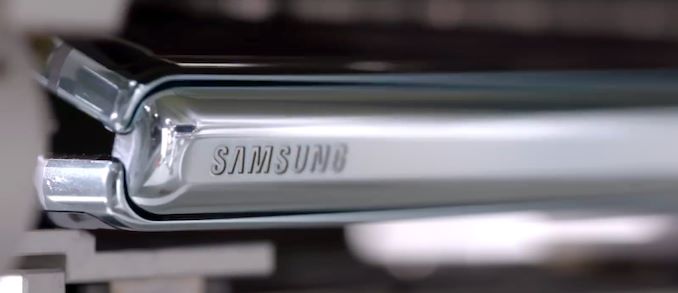
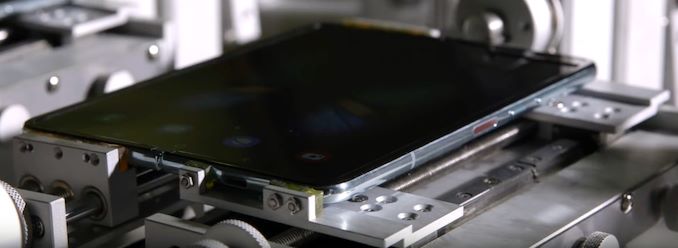
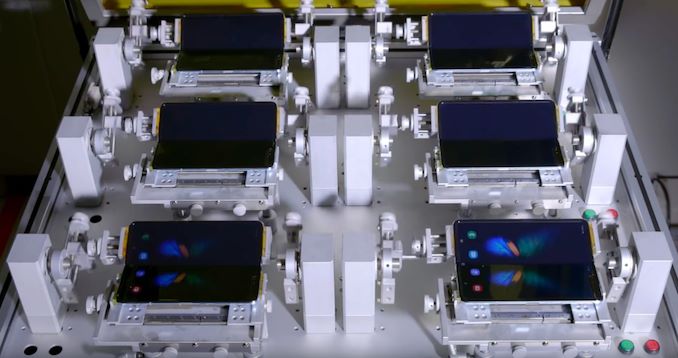
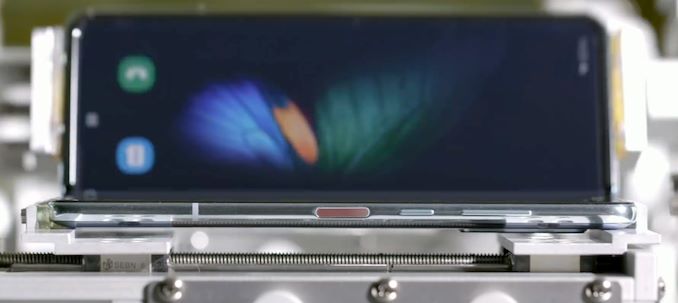








18 Comments
View All Comments
nicolaim - Thursday, March 28, 2019 - link
Typo: repetativec4v3man - Thursday, March 28, 2019 - link
Start injecting some dust/dirt into the air around the test units and let me know how many cycles it survives. I wouldn't expect it to handle 100 unfold cycles a day (there's an external display for a reason) so it doesn't need to work for 200,000 cycles, but I'd want to see evidence that it'd support 50,000 cycles under real-world conditions. Also, make sure you over-extend the hinge slightly each time... in real world use you're going to snap this thing open until it stops, you're not delicately and precisely extending it to 180* perfectly each time. You're going to be exerting force briefly after the device has reached it's full extent of travel. A perfectly precise test rig isn't testing for this, unless they account for that by making the "stationary side" attached with some sprung resistance, to allow for testing "past fully open".TheOtherOn - Friday, March 29, 2019 - link
Only?When you think about it, on average we can easly unlock our phone more than 50 times a day or even 100. Thats not even for a whole year and as others pointed about the wear and tear of usage over time in the human hands, they better test it for at least a million times!
Calin - Friday, March 29, 2019 - link
Well, early adopters will buy one of these, and in a couple of years at most will early adopt a different model. As such, 5 years reliability will not be expected by most of these buyers. And the second and third generations will probably quite a bit better in some ways, just as is expected with first generation products.Also, for these "early adopters" of $2000 phones, resale value might not have such a large influence - they'll probably just return the phone and sign a new contract for a new flagship phone.
Death666Angel - Friday, March 29, 2019 - link
"When you think about it, on average we can easly unlock our phone more than 50 times a day or even 100. Thats not even for a whole year "I don't get what your point is. Samsung says they test this thing to withstand about 100 foldings per day for 5 years. Which is a bit less than the 200k they test for. The quoted sentence above does not make sense to me in that regard. And 5 years already seems excessive to me. The people I know who spend a lot of money on their smartphones are precisely the people who buy a new one every one to two years. The people who use their smartphone a long time (I know some who still have Galaxy S2's and ones with broken displays) don't pay a lot for their smartphones, so they won't have anything like this for years.
FunBunny2 - Friday, March 29, 2019 - link
"The people I know who spend a lot of money on their smartphones are precisely the people who buy a new one every one to two years. The people who use their smartphone a long time (I know some who still have Galaxy S2's and ones with broken displays) don't pay a lot for their smartphones, so they won't have anything like this for years."ah, that ole chicken and egg problem. the smaller the production run, the higher the average cost (fixed cost spread over fewer units), and so is price but not profit. put the sources of that fixed cost into higher volume units, lower the average cost, boost revenue and profit. these are supposed to be the Smartest Guys in The Room?
Gunbuster - Friday, March 29, 2019 - link
Honestly more worried about micro and macro scratches in the plastic surface. Welcome back to the squishy plastic screen winmo/touch pro days people.s.yu - Monday, April 1, 2019 - link
Well I think it'll come with a protection film, a TPU film actually lasts pretty long.